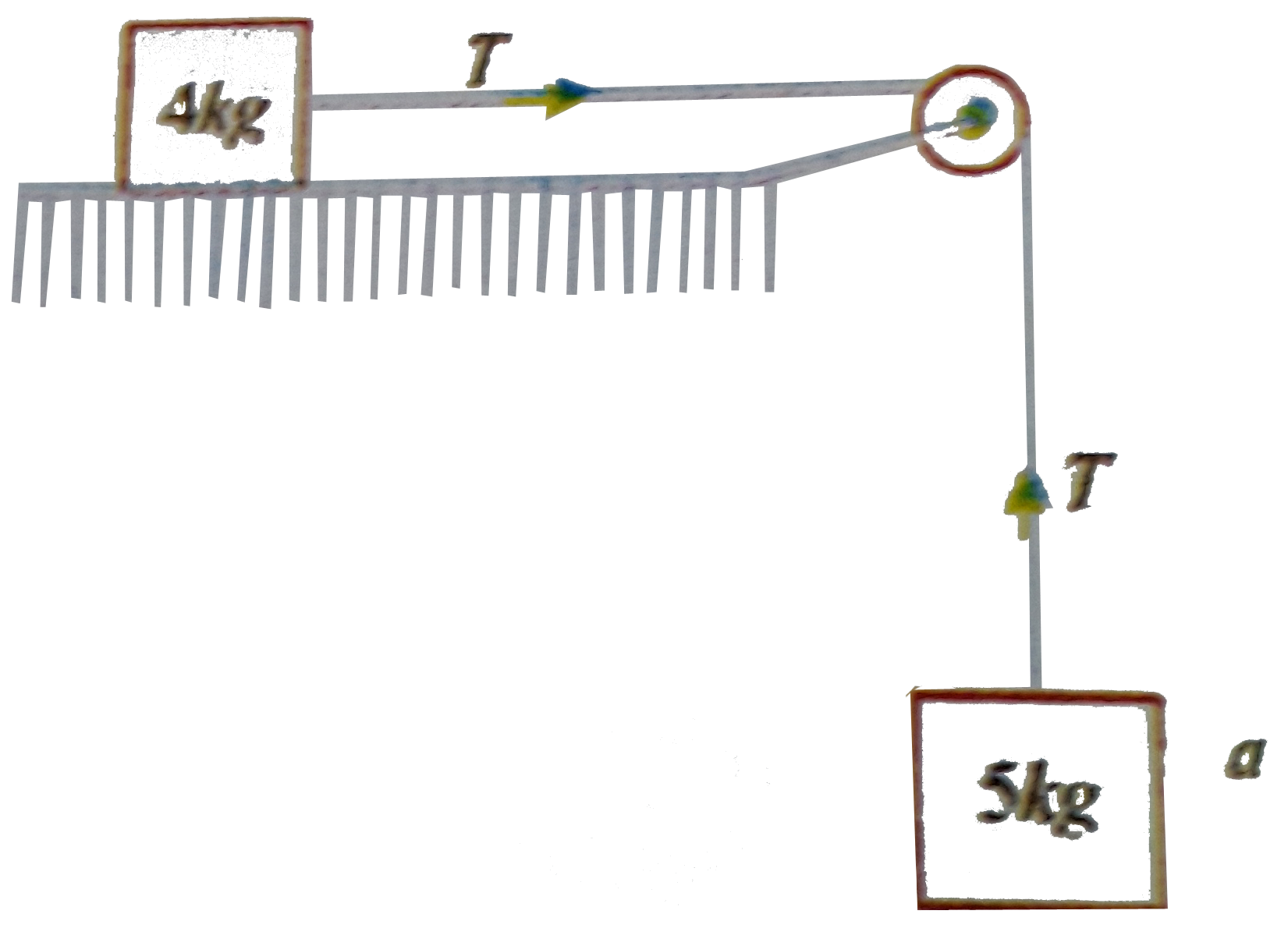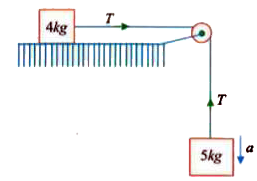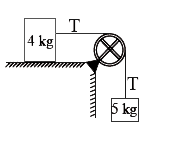Two bodies of masses 4 kg and 5kg are acted upon by the same force. If the acceleration of lighter body is 2m/sec2, then the acceleration of the heavier body is:-
4.2m/s2
3.6m/s2
2.4m/s2
1.6m/s2
The correct Answer is:D
To solve the problem step by step, we will use Newton's second law of motion, which states that F=m⋅a, where F is the force, m is the mass, and a is the acceleration.
Step 1: Identify the given data
- Mass of the lighter body, m1=4kg
- Mass of the heavier body, m2=5kg
- Acceleration of the lighter body, a1=2m/s2
Step 2: Calculate the force acting on the lighter body
Using Newton's second law:
F=m1⋅a1
Substituting the values:
F=4kg⋅2m/s2=8N
Step 3: Use the same force to find the acceleration of the heavier body
Since the same force acts on both bodies, we can write:
F=m2⋅a2
Where a2 is the acceleration of the heavier body. We already calculated F=8N and we know m2=5kg. Therefore:
8N=5kg⋅a2
Step 4: Solve for a2
Rearranging the equation to find a2:
a2=8N5kg=1.6m/s2
Final Answer
The acceleration of the heavier body is 1.6m/s2.
---
- Mass of the lighter body, m1=4kg
- Mass of the heavier body, m2=5kg
- Acceleration of the lighter body, a1=2m/s2
Using Newton's second law:
F=m1⋅a1
Substituting the values:
F=4kg⋅2m/s2=8N
Since the same force acts on both bodies, we can write:
F=m2⋅a2
Where a2 is the acceleration of the heavier body. We already calculated F=8N and we know m2=5kg. Therefore:
8N=5kg⋅a2
Rearranging the equation to find a2:
a2=8N5kg=1.6m/s2
The acceleration of the heavier body is 1.6m/s2.
Topper's Solved these Questions
- BOOK - ALLENCHAPTER - NEWTONS LAWS OF MOTIONEXERCISE - EXERCISE-III28videos
NEWTONS LAWS OF MOTION
- BOOK - ALLENCHAPTER - NEWTONS LAWS OF MOTIONEXERCISE - EXERCISE-I52videos
NEWTONS LAWS OF MOTION
- BOOK - ALLENCHAPTER - NEWTON'S LAWS OF MOTION & FRICTIONEXERCISE - EXERCISE (JA)4videos
NEWTON'S LAWS OF MOTION & FRICTION
- BOOK - ALLENCHAPTER - RACEEXERCISE - Basic Maths (Wave Motion & Dopplers Effect) (Stationary waves & doppler effect, beats)25videos
RACE
Similar Questions
Knowledge Check
- Question 1 - Select One
A body of mass 10kg is acted upon by two perpendicular force, 6N . The resultant acceleration of the body is.
A1ms−2 at an angle of tan−1(34) w.r.t. 8N forceB0.2ms−2 at an angle of tan−1(34) w.r.t. 8N forceC1ms−2 at an angle of tan−1(43) w.r.t. 8N forceD0.2ms−2 at an angle of tan−1(43) w.r.t. 8N force - Question 2 - Select One
A body of mass 10kg is acted upon by two per pendicular forces 6N and 8N. The resultant ac-celeration of the body is .
A1ms−2 at angle of tan−1(43)6N force .B0.2ms−2 at an angle of tan−1(43) w.r.t 6N force .C1ms−2 at an angle of tan−1(43) w.r.t 8N force .D0.2ms−2 at an angle of tan−1(43) w.r.t 8N force . - Question 3 - Select One
A toraue of magnitude 4000 N-m, acts on a body of mass 2 kg. If the angular acceleration produced in the body is 20 rad/s2, then the radius of gyration of the body is
A5 mB10 mC15 mD20 m
Two bodies of masses 5kg and 4kg are tied to a string as shown If the table and pulley are smooth, then acceleration of 5kg mass will be
 .View Solution
.View SolutionTwo bodies of masses 5kg and 4kg are tied to a string as shown. If the table and pulley are smooth, then acceleration of 5kg mass will be
 View Solution
View SolutionA body of mass 10 kg is acted upon by two forces each of magnitude 10 N making an angle of 60∘ with each other. Find the net acceleration of the body
View SolutionA body A mass m1 exerts a force on another body B of mass m2 . If the acceleration of B be a2 , then the acceleration (in magnitude) of A is
View SolutionTwo bodies of 5 kg and 4 kg are tied to a string as shown in the figure. If the surface and pulley both are smooth, acceleration of 5 kg body will be equal to :
 View Solution
View Solution

